If you’ve ever come across a bearded dragon that looks unusually large, there’s a good chance you were looking at a german giant bearded dragon. Known for their impressive size and bold appearance, the German giant bearded dragon is a unique morph that continues to capture the attention of reptile enthusiasts and breeders alike.
But how can you tell if your bearded dragon is truly part of this rare and sought-after lineage? In this article, we’ll walk you through the essential traits, growth patterns, and verification tips to help you identify a true German giant bearded dragon—and avoid being misled by myths or mislabels. Whether you’re a curious owner or an aspiring breeder, this guide will give you the confidence to spot the real deal.
What Sets the German Giant Bearded Dragon Morph Apart from Other Bearded Dragons
Origins of the German Giant Bearded Dragon Line
The origins of the German Giant line date back to the early 1990s when breeders in Germany began selectively pairing unusually large bearded dragons. These dragons exhibited fast growth rates, thicker builds, and longer limbs compared to standard varieties. The goal was to isolate and enhance these traits over generations.
Eventually, some of these giants were exported to the United States, where American breeders continued the lineage. Through careful genetic selection, they established what is now recognized as the German Giant morph. Unlike other bearded dragon variations that focus on color or pattern, this line was bred specifically for size and robustness.
Today, many dragons are labeled as “giant” without having any true connection to this original bloodline. That’s why understanding the background of the German Giant lineage is crucial—it helps ensure you’re not mistaking a large adult for a genetically authentic giant.
Morph Characteristics vs Standard Dragons
One of the most noticeable differences between this morph and standard bearded dragons is size. While typical adults reach 18 to 22 inches in length, giants often grow beyond 24 inches and can weigh significantly more. However, size alone isn’t the only distinguishing factor.
This particular morph usually displays a bulkier frame, broader head, and thicker limbs. Their bodies tend to appear more muscular and solid, even at younger ages. Some individuals may also show slightly different scale texture, appearing rougher or more pronounced than their standard counterparts.
Another subtle trait is their appetite. These dragons often eat more and grow faster during the juvenile stage, requiring a nutrient-rich diet and proper UVB exposure to support their development.
It’s important to note that environmental factors can cause a regular bearded dragon to appear large. What sets true morphs apart is consistency in size and body shape across bloodlines, not just one well-fed individual. Comparing build, behavior, and growth rate gives a clearer picture of authenticity.
Why Size Isn’t the Only Factor in Identifying a German Giant Bearded Dragon
Many reptile owners assume that a large bearded dragon automatically belongs to a giant morph, but that’s not always the case. Size can be influenced by several non-genetic factors, including diet, enclosure size, and general health. A well-fed dragon living in optimal conditions may appear large, even if it doesn’t come from a giant bloodline.
True giants exhibit more than just impressive length or weight. Their bone structure tends to be thicker, with broader heads and stronger limbs. They often display consistent traits across siblings and generations—something that’s only possible through selective breeding.
In addition to physical features, growth rate and temperament can also provide clues. Genuine morphs typically grow faster during their early months and may have more robust energy levels. These details matter because size alone can be misleading.
To accurately determine if your dragon is part of this rare lineage, it’s important to evaluate the full picture—not just body length. Bloodline, build, and developmental history all contribute to identifying a true morph with confidence.
The Role of Selective Breeding in Morph Development
Selective breeding plays a critical role in the creation of unique reptile morphs. Breeders carefully choose parent dragons that exhibit desirable traits, such as size, color, or scale texture. Over several generations, these traits become more pronounced and consistent.
In the case of oversized morphs, the goal was to produce dragons with larger frames and stronger physical features. Breeders selected the biggest, healthiest individuals and paired them to pass on their size-related genes. This process took time, but it eventually led to the development of lines known for their impressive stature.
Unlike random breeding, selective breeding is intentional and focused. It requires keeping detailed records, tracking traits across multiple clutches, and avoiding genetic weaknesses. This is how true morphs are preserved and improved.
Without selective breeding, most reptiles would resemble their wild counterparts. It’s this deliberate process that gives rise to specialized morphs seen in the pet trade today. Understanding how these traits are passed down helps distinguish authentic lines from lookalikes.
Selective breeding doesn’t just produce German Giants—it’s also responsible for other fascinating morphs like the Citrus, Leatherback, and Zero.
Discover the top 5 morphs created through bearded dragon selective breeding in this article.
Visual and Physical Traits to Help You Identify a True German Giant Bearded Dragon
Typical Size and Growth Rate
One of the most noticeable traits of a true giant is its size—and how quickly it gets there. While standard bearded dragons typically reach about 18 to 22 inches in length as adults, a fully grown oversized dragon can measure 24 to 26 inches or more. Some even push beyond that range, depending on genetics and care.
Growth rate is another key difference. A genuine morph often grows faster during its juvenile phase, gaining both length and weight more rapidly than average dragons. This accelerated growth usually starts within the first few months and can continue for up to 18 months.
It’s important to note that size alone doesn’t confirm a dragon’s genetic identity. Environmental factors such as diet, enclosure size, and lighting can also impact how large a dragon becomes. However, when consistent size and rapid growth appear across multiple siblings, it strongly suggests a true giant lineage.
Tracking growth month by month can help owners spot early signs of oversized development, especially when compared to average growth charts.
Body Structure and Build
The body structure of a true giant stands out immediately, even when compared to other healthy dragons. Oversized dragons often have a thicker, more muscular frame that appears broader through the chest and shoulders. Their limbs are also stockier, with noticeably stronger forearms and hind legs.
Another defining feature is the head size. True giants usually have a wider, more pronounced skull with a blockier jawline. This gives them a bold and powerful appearance, even as juveniles. The tail tends to be thicker at the base and slightly longer in proportion to the body.
Unlike average dragons that may look lean or slender, these oversized morphs give off a sturdier, more grounded impression. Their body mass is evenly distributed, creating a bulky silhouette that persists even when not fully grown.
While a well-fed dragon can look big temporarily, a genuine morph will show consistent thickness across all body parts—regardless of age or feeding habits. This physical consistency is a reliable clue when identifying a true giant.
Scale Texture and Skin Coloration
While size and build are the most obvious traits, scale texture and skin coloration can also provide helpful clues when identifying a true giant. Many oversized dragons have slightly rougher or more pronounced scales, especially along the back and sides. These scales often appear more defined and rigid compared to the smoother textures seen in other morphs like leatherbacks.
Skin color can vary, as this morph was bred for size rather than pigmentation. However, some true giants tend to display muted earth tones—such as browns, grays, and subtle oranges—that blend with their bulky appearance. These colors may become deeper or more intense as the dragon matures.
It’s important to remember that coloration alone doesn’t confirm a dragon’s genetic background. Still, when paired with a solid frame and strong lineage, unique scale patterns and tones can support the identification of an authentic oversized dragon.
Observing texture during shedding cycles may also help. True giants often show more dramatic flaking due to thicker skin layers.
Nail, Tail, and Limb Proportions
The finer physical details of a true giant often reveal just as much as overall size. One of the most overlooked indicators is limb proportion. Oversized dragons usually have noticeably thicker legs and longer toes. Their limbs are muscular, with a sturdier appearance that supports their heavier body weight.
Nail structure also plays a role. While it varies among individuals, true giants often have slightly longer and more curved nails. These nails can appear more prominent, especially on the front feet, and may require more frequent trimming than those of standard-sized dragons.
The tail is another key feature. In a genuine oversized dragon, the tail tends to be both thicker and longer in proportion to its body. It often tapers more gradually and may feel denser to the touch.
These subtle differences in nail, tail, and limb structure help set apart a true giant from a healthy but average-sized bearded dragon. When combined with growth rate and build, these features provide stronger evidence of an authentic morph.
| Image | Section | Purpose | Visual Type |
|---|---|---|---|
| 1 | Morph Characteristics vs Standard Dragons | Immediate size/build comparison | Side-by-side photo |
| 2 | Typical Size and Growth Rate | Visual growth timeline | Size chart |
| 3 | Nail, Tail, and Limb Proportions | Support physical trait identification | Close-up detail |
| 4 | Asking for Breeder Documentation | Build trust + show authenticity | Certificate-style layout |
| 5 | Ideal Enclosure Size and Setup | Educational value + care advice | Habitat showcase |
German Giant vs Regular Bearded Dragon: Key Differences
Side-by-Side Size Comparison Chart
When trying to determine if your dragon belongs to an oversized morph, size comparison is a great starting point. A true giant typically grows faster and larger than a standard bearded dragon, especially during the first year of life.
At around 6 months old, a regular dragon might measure 12 to 14 inches in length. In contrast, a young oversized dragon could already exceed 16 inches. By adulthood, standard dragons usually reach 18 to 22 inches, while giants often grow to 24–26 inches—or more in some cases.
Weight also plays a role. A healthy adult bearded dragon may weigh 400 to 500 grams, while a true giant can weigh up to 700 grams or beyond. These size differences are most obvious when tracked month by month using a simple growth chart.
Using a side-by-side comparison helps visualize the contrast between a standard and an oversized dragon. It also helps prevent confusion caused by overfeeding or accelerated early growth that may mimic true giant traits in regular dragons.
A side-by-side comparison is one of the easiest ways to spot a bold difference between a standard bearded dragon and a bold German Giant Bearded Dragon. While both may look similar at first glance, their growth patterns and final size are noticeably different over time.
At 6 months, a typical bearded dragon might measure around 12 to 14 inches. In contrast, a German giant bearded dragon often reaches 16 inches or more at the same age. By adulthood, standard dragons average 18 to 22 inches in length, while a German giant bearded dragon can grow to 24–26 inches or even longer in rare cases.
Weight is another clue. Standard dragons usually weigh between 400–500 grams as adults. True giants can reach 600–700 grams or more, depending on diet and care.
Creating a monthly growth chart helps visualize this difference clearly. It prevents confusion between well-fed dragons and those that are genetically oversized. If your dragon consistently outpaces normal growth milestones, you may be caring for a German giant bearded dragon without even knowing it.
Differences in Feeding and Growth Stages
The german giant bearded dragon shows distinct differences in both feeding habits and growth rate when compared to a standard bearded dragon. One of the earliest signs of this morph is an increased appetite during the juvenile stage, often requiring more frequent and larger meals to support its rapid development.
While most young dragons eat insects several times a day, the german giant bearded dragon typically consumes more and grows at a noticeably faster pace. Because of this accelerated growth, it may outgrow its enclosure sooner than expected, prompting earlier upgrades to tank size and habitat setup.
Standard bearded dragons grow steadily over 12 to 18 months, but a german giant bearded dragon may reach impressive lengths and body mass well before that. To support this growth, a diet high in protein during the early months is crucial, followed by a gradual shift toward leafy greens, calcium, and other supplements.
It’s important to avoid overfeeding a standard dragon in an attempt to mimic giant traits. Only a consistent growth curve, paired with genetic lineage and physical structure, can confirm the identity of a true german giant bearded dragon. Monitoring meal frequency, portion size, and monthly weight gain will provide better insight into whether you’re caring for a genuine giant or just a healthy standard morph.
Behavioral Patterns Observed in Giants
Beyond physical traits, behavioral patterns can also help identify a German Giant bearded dragon. These oversized morphs often exhibit slightly different energy levels, routines, and responses compared to their standard counterparts.
Many owners report that German Giants tend to be more confident and bold, especially when exploring new environments. They may show increased interaction with their surroundings, such as climbing more frequently or actively approaching the glass when they see movement. This behavior often starts at a young age and becomes more noticeable as the dragon matures.
Some individuals also display higher food motivation. They may respond quickly during feeding times and show excitement when presented with new food options. While not true for every dragon, this trend appears more commonly in larger morphs.
Despite their size, German Giants usually retain a calm and friendly temperament. They are often easy to handle and less skittish, making them a favorite among experienced reptile keepers. Observing these behavioral cues, along with physical features, adds another layer of insight when identifying a true morph.
Common Myths About Giant Morphs
There are many myths surrounding giant bearded dragon morphs, and these often lead to confusion for new owners. One common belief is that any large bearded dragon must be a true giant. In reality, size alone is not a reliable indicator. A well-fed dragon kept in ideal conditions can grow larger than average without having giant genetics.
Another widespread myth is that all giant morphs are aggressive or harder to manage. In fact, most oversized dragons are calm, friendly, and easy to handle—often making them ideal pets for experienced keepers.
Some sellers may claim that giants are a separate species. This is false. Giant morphs still belong to the same species, Pogona vitticeps. Their size comes from selective breeding, not species variation.
Finally, there’s a belief that giant morphs require drastically different care. While they may need a larger enclosure and slightly more food, their overall care is similar to that of regular bearded dragons.
Understanding these myths is important for anyone considering a German Giant. Knowing what’s true and what’s marketing hype can help you make better choices as a reptile owner.
How to Confirm Lineage and Bloodline Authenticity
Asking for Breeder Documentation
When purchasing a German Giant bearded dragon, requesting breeder documentation is one of the most important steps. Legitimate breeders often keep detailed records of their breeding lines, including hatch dates, parent morphs, and size history. These documents help prove whether the dragon comes from a recognized giant lineage or not.
Documentation may include photos of the parents, growth charts, and notes on genetic traits passed through the bloodline. While not every breeder offers official certificates, those who specialize in morph breeding typically maintain traceable records.
If a seller refuses to provide basic information or avoids questions about lineage, that’s a red flag. Reputable breeders are transparent and willing to share their dragon’s background. Asking for this documentation not only protects you as a buyer but also helps ensure the dragon you bring home is a genuine giant and not simply a large adult from a standard line.
German Giant Bloodline Reputations
Not all giant morphs are created equal, and some bloodlines are better known than others for consistency in size and temperament. Over the years, a few breeders have built strong reputations for producing high-quality German Giant dragons. These lines are often referenced in reptile communities and breeder forums for their reliability and traits.
Recognized bloodlines tend to have more predictable growth rates, stronger body structures, and a clearer history of genetic selection. Purchasing from a known line adds confidence that the dragon is more than just large—it’s bred to carry the true morph identity.
Some reputable bloodlines may be named after the breeder or the founding pair. In contrast, unknown or unverified lines often lack historical data or produce inconsistent results. If you’re serious about owning a true morph, researching and selecting a dragon from a respected bloodline can make a significant difference in long-term health and authenticity.
How Reputable Breeders Verify Morph Identity
Reputable breeders don’t rely on guesswork when identifying morphs—they use careful tracking and selective pairing to maintain integrity. Morph verification begins with choosing dragons that consistently show the right physical and genetic traits over several generations.
A professional breeder will monitor each clutch from hatchling to adult, recording data such as size milestones, feeding patterns, and behavioral traits. They’ll also compare offspring to previous generations to ensure consistency in growth and appearance. This long-term observation helps separate a true morph from dragons that just happen to be large.
Most experienced breeders also participate in reptile expos or online communities, where their reputation is tied to the accuracy of their listings. If a breeder regularly produces dragons claimed to be giants, but the traits don’t align, they’ll quickly lose credibility.
When in doubt, ask breeders how they track and verify their morphs. Their answers can reveal whether they follow a professional process or simply use the label for marketing purposes.
Genetic Testing and Morph Confirmation
Although not common practice for all owners, genetic testing is the most definitive way to confirm a bearded dragon’s morph status. For breeders and collectors who prioritize bloodline purity, testing offers an extra layer of certainty. It can reveal inherited traits, recessive genes, and even potential health risks.
Some specialized labs offer reptile DNA testing services, which analyze samples to match known morph markers. These tests can be costly and may require a vet to collect the sample, usually a small blood draw or shed skin.
While not necessary for the average pet owner, genetic confirmation is a valuable tool in breeding programs. It helps ensure that future pairings are genetically compatible and that the morph line remains stable.
If you’re unsure about your dragon’s lineage and documentation is limited, consulting a vet who works with reptiles is a good starting point. They may recommend testing or refer you to breeders who prioritize genetic accuracy in their programs.
Tips for Caring for Oversized Bearded Dragons
Ideal Enclosure Size and Setup
A German Giant bearded dragon requires more space than a standard morph due to its larger size and active nature. While a 40-gallon tank may be acceptable for juveniles, adult oversized dragons thrive in enclosures that are at least 120 gallons or larger. The minimum recommended dimensions are 4 feet long, 2 feet wide, and 2 feet high.
Horizontal space is more important than height, as bearded dragons are ground-dwelling reptiles. Include sturdy branches, low basking platforms, and hiding spots to encourage natural behaviors. Proper ventilation and secure lids are also essential to maintain safety and airflow.
Using a bioactive or naturalistic substrate, like tile or a sand-soil mix, can create a healthier and more enriching environment. Regular cleaning and spot-checking help prevent odor and bacteria buildup.
Oversized dragons need room to move comfortably, stretch fully, and regulate their body temperature effectively. A cramped enclosure can lead to stress, muscle weakness, and health problems. Providing the right setup from the start helps ensure long-term well-being.
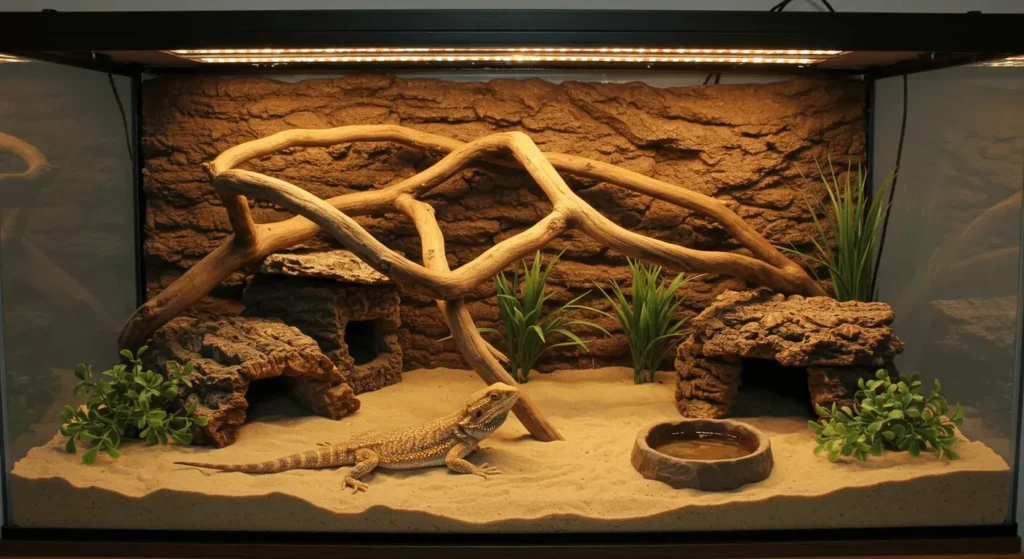
Feeding and Supplement Needs
Feeding a German Giant bearded dragon requires attention to both quantity and nutritional quality. These dragons typically eat more than standard morphs and have a higher protein demand during their rapid growth phase. Juveniles may need to be fed insects two to three times daily, while adults can shift to a mix of greens, vegetables, and insects several times a week.
Gut-loaded insects such as crickets, dubia roaches, and black soldier fly larvae are excellent protein sources. Leafy greens like collard, mustard, and dandelion provide vital vitamins and fiber. Avoid feeding spinach or iceberg lettuce due to their low nutritional value and potential calcium-binding effects.
Calcium with vitamin D3 should be dusted on insects three to four times per week for juveniles and twice per week for adults. A multivitamin supplement can be added once weekly.
Because these dragons grow larger and faster, nutrient deficiencies can develop quickly without a balanced diet. Monitoring weight, energy levels, and shedding patterns helps ensure their diet is meeting all developmental needs.
Handling and Health Monitoring
Oversized dragons are typically calm and tolerant of handling, which makes routine health checks easier for owners. However, their larger size means that support is crucial. Always lift your dragon using both hands—one under the chest and the other supporting the tail and hind legs.
Giant morphs may be prone to joint strain or muscle fatigue if improperly supported. Avoid lifting from the tail or letting them hang unsupported, especially during longer handling sessions.
Health monitoring should include regular weight checks, observation of stool consistency, appetite, and shedding behavior. Early signs of illness may include lethargy, sunken eyes, weight loss, or poor response to stimuli.
Scheduling annual check-ups with a reptile vet is recommended, especially for monitoring bone density, parasites, or metabolic disorders. Because German Giant dragons consume more food, they may be at slightly higher risk of obesity if their diet isn’t balanced with activity.
Gentle, consistent handling builds trust while also giving you the chance to detect early signs of stress or illness.
Special Lighting and Heating Considerations
Proper lighting and heating are essential for any bearded dragon, but they’re even more important for larger morphs. A German Giant bearded dragon has a greater body mass, which can affect how efficiently it absorbs UVB and regulates temperature.
Use a high-output T5 UVB tube that spans at least two-thirds of the enclosure length. This ensures that the dragon receives consistent UVB exposure throughout the day. Replace UVB bulbs every six months, even if they still appear bright.
Basking temperatures should range between 100°F and 110°F, while the cool side of the tank should remain around 75°F to 85°F. Because giants generate more body heat, it’s important to monitor these zones with a digital thermometer to avoid overheating.
Ceramic heat emitters or radiant heat panels may be used at night if room temperatures fall below 65°F. Avoid colored bulbs at night, as they can disrupt your dragon’s sleep cycle.
Providing a strong light and heat gradient helps oversized dragons maintain proper digestion, energy, and immune function. Skipping these essentials can lead to long-term health issues such as metabolic bone disease or sluggish behavior.
Frequently Asked Questions
1. How big does a German Giant bearded dragon get?
German Giant bearded dragons typically grow between 24 to 26 inches in length, with some even reaching beyond that under optimal care. Their size is noticeably larger than standard bearded dragons.
2. What is the average weight of a German Giant bearded dragon?
A healthy adult German Giant can weigh anywhere from 600 to 800 grams, depending on genetics, diet, and overall care.
3. What is the typical lifespan of a German Giant bearded dragon?
With proper care, the average lifespan of a German Giant bearded dragon is 10 to 12 years, similar to standard morphs.
4. What’s the difference between a German Giant and a normal bearded dragon?
The main difference lies in their size, growth rate, and overall build. German Giants grow faster, reach a larger adult size, and have bulkier body structures compared to normal bearded dragons.
5. Are German Giant bearded dragons extinct or rare?
German Giants are not extinct, but they are considered rare. True giants come from specific bloodlines, and not all large dragons are genuine morphs.
6. How much does a German Giant bearded dragon cost?
Prices for German Giant bearded dragons range from $250 to $600 or more, depending on age, lineage, and breeder reputation.
7. Where can I find a German Giant bearded dragon for sale in the USA?
You can find German Giant bearded dragons for sale in the USA through reputable reptile breeders, specialty pet stores, and reptile expos. Always ask for lineage documentation before buying.
8. Is it worth buying a German Giant bearded dragon over a standard one?
If you’re looking for a unique, impressive pet and have the space to accommodate its size, a German Giant bearded dragon can be a rewarding choice. However, it requires slightly more care, space, and food.
Conclusion
Identifying a true german giant bearded dragon goes far beyond judging by size alone. While their impressive length and bulky build are standout traits, it’s the consistent growth pattern, documented lineage, and specific physical features that confirm their authenticity. Understanding the history, care needs, and behavioral traits of these oversized dragons allows you to distinguish between a genuine morph and a standard bearded dragon that simply appears large.
Whether you’re looking to purchase a german giant bearded dragon, confirm your current pet’s identity, or simply learn more about this rare morph, having the right knowledge is key. Always ask for breeder documentation, observe physical traits carefully, and provide proper care suited for their larger size.
By staying informed, you’ll not only make better decisions as a reptile owner but also help preserve the integrity of the german giant bearded dragon bloodline for future enthusiasts.

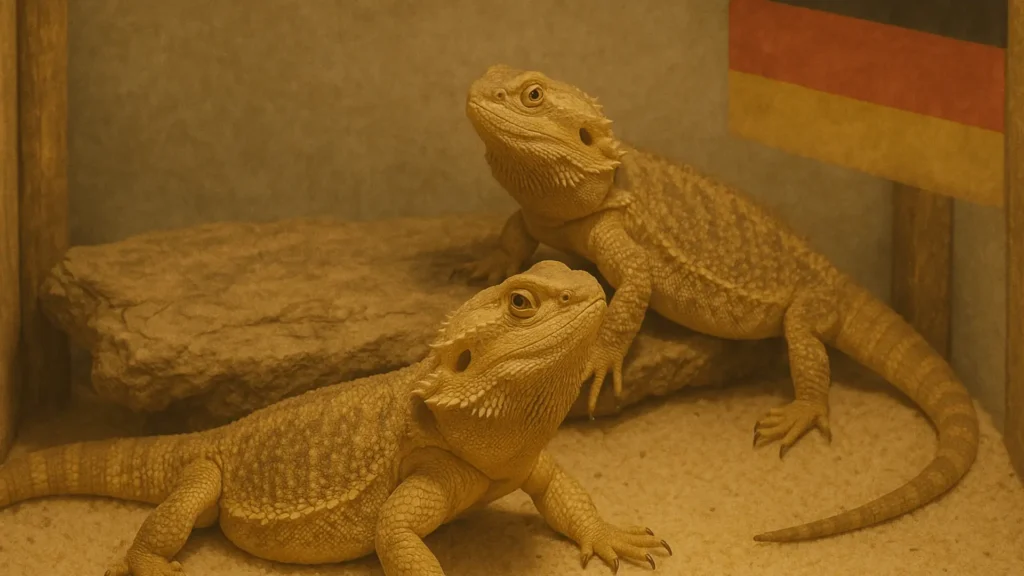
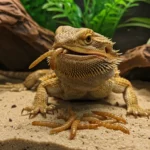

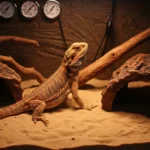
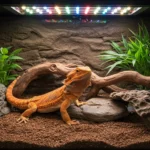
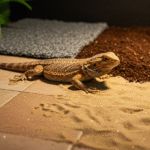
1 thought on “How to Identify a True german giant bearded dragon”